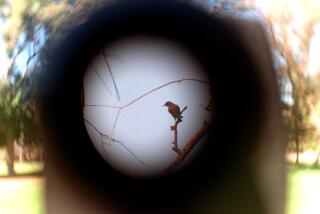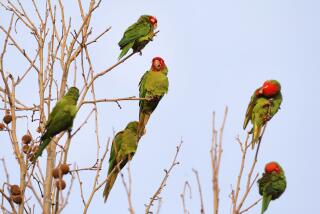How Tweet It Is Around Hong Kong
KOWLOON, Hong Kong â A manâs reputation here rests not on the company he keeps or the dogs he owns, but on the birds he walks.
Youâll find thereâs more to Hong Kong than shopping and dim sum. For in this high-density, high-rise city, the popular pet of choice is the bird.
If you are up early, like most of the locals, you can hear the song of the thrush as it hops about its cage swinging from the limb of a mulberry tree, joining a host of others in an arbor of trees dripping bird cages.
âBird lovers,â as they are called, sling these bamboo domiciles on branches, creating a special primeval forest for their feathered pets.
Devotees, believing that birds cooped up indoors in the cityâs crowded apartments will become depressed and lose their will to sing, head for parks with their caged companions at about 5 or 6 a.m. everyday. They hope to make the birdâs day brighter and to enhance their warbling through discourse with other birds.
Chances are youâll encounter a little Oriental man swinging his bird cage gently as he saunters into Kowloon Park for his morning ritual.
Network of Narrow Paths
He meanders up and back the network of narrow paths. No lost soul, he is a man with a mission: to increase the contentment of his winged friend.
Every so often he will stop, greet friends, place the cage at his feet and join them on a park bench where they will talk. This is a daily social event for both man and bird. Shortly, the old man will rise, carefully raise his cage and continue his stroll.
Itâs 7 a.m. and more friends and their birds await on the tree-lined terrace amid the âshadow boxers,â the ubiquitous tai chi exercisers.
Behind the old man, a young man in jogging suit, carries two white draped cages--one perched on his shoulder, the other carefully balanced on one palm like a waiter carrying a tray.
He removes the covers and hangs each cage from a branch of a tree, then begins his stretching. The little warblers serenade each other, joining the caroling, squawking and chirping that fills the park.
The men (women reportedly walk their birds later in the day) are observing an ancient Chinese ritual dating back centuries to the Imperial Qing dynasty of the Manchus.
When these nomads broke through the Great Wall in 1644 and conquered Beijing, they introduced the art of bird raising.
A Privileged Elite
The conquerors became privileged elite, favored for life by the emperor with an imperial living allowance, which freed them from the drudgery of working for a living.
They spent their idle time in tea houses, gossiping, listening to storytellers and discussing the intricacies of feeding and raising birds.
Ancient cartoons captured these idle rich fanning themselves with one hand, while holding a bird cage in the other.
In 1911, the former noble loafers, lacking work skills, were forced into the common market--street vendors, porters, rag collectors--but their fanatic devotion to birds survived to this day.
Such devotion has spawned a street devoted exclusively to the selling of birds and their accouterments.
The hobby has also given rise to restaurants that cater to these fanciers, supplying them with bamboo poles on which to hang their cages while they eat and socialize.
However, itâs not all fun and games. Bird raising is a time-consuming and exacting hobby. The feathered creatures must be bathed and the white sand at the bottom of the cage (newspapers are forbidden) changed daily.
Strict Etiquette
Even walking adheres to a strict etiquette. Cages are draped with starched white-cotton covers to protect its occupants from traffic noises and passers-by, and, allegedly, to ward off cockroaches and mosquitoes.
A chick has to be swung gently to strengthen its wings and so it can adapt to its new environment. Adult songbirds, on the other hand, need less walking, but require dialogue with others to increase their tonal range. The best have been known to mimic as many as seven voices.
Toward this end, following the outing, somewhere between 7 and 8 a.m., bird lovers with their cages rendezvous daily for morning tea at one of many âbird restaurantsâ to compare pets and argue the finer points of care and feeding.
Cage-Carriers Congregate
For half a century, the most popular meeting place for this ritual has been the top floor of Wan Loi restaurant, 484 Shanghai St., where hundreds of cage-carriers have been known to congregate, particularly on Sundays and holidays.
Thereâs a restaurant for dim sum and strong Chinese tea on the ground and first floors. Exotic odors waft from large wooden boxes of herbs and spices at the entrance.
On another floor, the top of a wide, curving staircase opens onto a large room of tumultuous squawking and chirping and a frenzy of fluttering wings from cages of birds perched on tables, suspended from poles and set before open windows.
Regulars arrive when the restaurant opens at 5:30 a.m. to reserve a spot at the window. By 7 a.m., the room is bustling.
Up and Down the Aisles
Some owners walk cages up and down the aisles so their birds can converse or eavesdrop on their chums to pick up a chirp or two; others sit at tables with cages open, drinking tea and stroking their pets.
By 9 a.m. the room has emptied as executives in suits rush off to offices and the retired elders return home to feed and bathe their companions. A fancier may own as many as five birds, which are rotated, usually by twos, for outings.
Itâs an expensive hobby--birds reportedly costing $30 and up, plus accessories that raise the ante even more.
The shopping mall for birds and supplies is Hong Lok Street, alias âBird Street,â in Mongkok, near the junction of Argyle and Shanghai streets, just off Nathan Road, Kowloonâs main shopping avenue.
This narrow-canopied alley, reserved for foot traffic only, features a maze of accessories and birds in all colors and sizes, from tiny sparrows to large, colorful parrots. Many of the birds come from China and southeast Asia. Life expectancy is about 10 years.
Songless Females
Most highly prized are the song birds, including the seung see (a miniature canary with yellow/green plumage), the wah mei (brown thrush with a white streak over the eyes), crimson cockatoos and gray finches.
In China, he who mistakenly buys a female thrush chick loses face. In maturity itâs the males who sing; the females remain songless.
When a sale is completed, after lively bargaining with onlookers joining in, the new owner departs, adopting the prescribed protocol of newly purchased bird handling.
Cages are carried at head or chest level for maximum display of the new purchase and to safeguard the serenity of the bird en route home.
Cages range in price and degree of artistry from an inexpensive mock bamboo of reddish brown plastic to a carved, polished and stained bamboo that can cost more than $60.
Cage Accouterments
Ivory carving for cage accouterments is an honored profession perpetuated in families from one generation to the next.
Cages are usually outfitted with four small bowls--two for grains or seeds and morsels of fruits and vegetables, and two for water.
A delicate vase is often placed inside for decoration. Many hobbyists even theorize that each species has a preference in cages.
But the birds have a food preference. Their favorite delicacy, live grasshoppers, is imported from China with special dispensation from the customs department and eaten at a rate of three to 50 daily per bird.
Grasshoppers vary in price according to season (winter higher than summer). You also can buy a cage to house the grasshoppers to ensure a steady, fresh supply. A birdâs diet is given serious consideration--special balance of seed, fruits, vegetables and live fare, carbohydrates and vitamins.
Nothing Is Too Good
In other stalls, worms slither in open containers and cicadas and crickets click and hop in display cages--for a sometimes steep price.
But pay it they do; nothing is too good for the birds: Complex sliding doors for cages, elaborately carved ivory perches and ornate cloisonne or blue-and-white ceramic water bowls resembling ancient porcelain vases.
An old Chinese saying alleges that he who keeps a contented bird in his house brings in nature and relaxes the mind.
More to Read
Sign up for The Wild
Weâll help you find the best places to hike, bike and run, as well as the perfect silent spots for meditation and yoga.
You may occasionally receive promotional content from the Los Angeles Times.






